» posted on Saturday, May 25th, 2013 by Linda Lou Burton
Jeff City
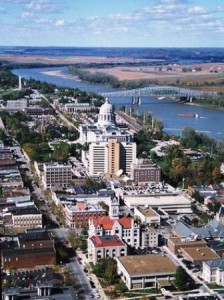 Linda Burton posting from Jefferson City, Missouri – The City of Jefferson. That’s the official name of Jefferson City, although locals affectionately call it Jeff City, or just home. Somebody wanted to name it Missouriopolis, way back in its beginnings, but it wound up being named for Thomas Jefferson; I’m sure schoolchildren learning to spell are glad of that. If you’re wondering why such a small city in such an out-of-the-way place is the designated state capital, the answer is found in the 1820 constitution of the soon-to-be-state of Missouri. Under Article X, Of the Permanent Seat of Government, the General Assembly was directed to name five commissioners to select a site for a capital city, with the stipulation “that no place shall be selected which is not situated on the bank of the Missouri River, and within forty miles of the mouth of the river Osage.” Rivers were the highways of the frontier, you see, “forever free to the citizens of this state and of the
Linda Burton posting from Jefferson City, Missouri – The City of Jefferson. That’s the official name of Jefferson City, although locals affectionately call it Jeff City, or just home. Somebody wanted to name it Missouriopolis, way back in its beginnings, but it wound up being named for Thomas Jefferson; I’m sure schoolchildren learning to spell are glad of that. If you’re wondering why such a small city in such an out-of-the-way place is the designated state capital, the answer is found in the 1820 constitution of the soon-to-be-state of Missouri. Under Article X, Of the Permanent Seat of Government, the General Assembly was directed to name five commissioners to select a site for a capital city, with the stipulation “that no place shall be selected which is not situated on the bank of the Missouri River, and within forty miles of the mouth of the river Osage.” Rivers were the highways of the frontier, you see, “forever free to the citizens of this state and of the 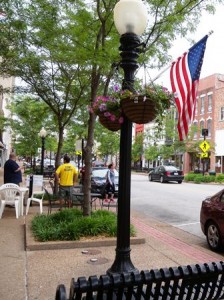 United States;” waterways carried the freight and passengers pushing west. The spot chosen is actually 18 miles from the mouth of the Osage; and although a few overrides of that dictum have been tried over the years; here it remains. Jeff City is what you have in mind when you think of the ideal small town; American flags fly permanently from every street post; flower pots grace the sidewalks where outdoor tables invite you to sit and eat. On weekends, traffic lights are set to blinking red, making them four-way stops; no hurry; no wasted time. It has a 60’s look, in fact, that’s the idea. I’ve heard that a purring cat in your lap lowers blood pressure by ten points; I say so does a sidewalked town, with trees, and benches, and petunias.
United States;” waterways carried the freight and passengers pushing west. The spot chosen is actually 18 miles from the mouth of the Osage; and although a few overrides of that dictum have been tried over the years; here it remains. Jeff City is what you have in mind when you think of the ideal small town; American flags fly permanently from every street post; flower pots grace the sidewalks where outdoor tables invite you to sit and eat. On weekends, traffic lights are set to blinking red, making them four-way stops; no hurry; no wasted time. It has a 60’s look, in fact, that’s the idea. I’ve heard that a purring cat in your lap lowers blood pressure by ten points; I say so does a sidewalked town, with trees, and benches, and petunias.
Jefferson City has about 43,079 relaxed people (US Census 2010), the 10th smallest of the capital cities (making it the 41st largest); Olympia, Washington (46,478) and Concord, New Hampshire (42,695) are comparable in size. Geologically speaking, it sits on the northern edge of the Ozark Plateau and the south side of the Missouri River, almost in the middle of the state – Mid-Missouri, Middle America. It is at the western edge of an area known as the Missouri Rhineland, a major wine-producing region, with a distinct German heritage.
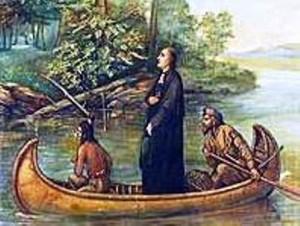 Before European settlers began to arrive, the area was inhabited by the Osage Indians; French explorers Joliet and Marquette came through about 1673; LaSalle claimed the area for France in 1682. By the mid-1700’s settlements at Ste Genevieve and St Louis built up; in 1762 Spain entered the picture. You know what happened in 1803 with the Louisiana Purchase; from there American exploration and expansion flourished; Lewis and Clark came on the Missouri River; Daniel Boone carved out Boone’s Lick Trail (now Interstate 70). Both the Santa Fe Trail and the Oregon Trail branched westward from Missouri.
Before European settlers began to arrive, the area was inhabited by the Osage Indians; French explorers Joliet and Marquette came through about 1673; LaSalle claimed the area for France in 1682. By the mid-1700’s settlements at Ste Genevieve and St Louis built up; in 1762 Spain entered the picture. You know what happened in 1803 with the Louisiana Purchase; from there American exploration and expansion flourished; Lewis and Clark came on the Missouri River; Daniel Boone carved out Boone’s Lick Trail (now Interstate 70). Both the Santa Fe Trail and the Oregon Trail branched westward from Missouri.
Statehood came for Missouri August 10, 1821; it was the 24th state admitted to the Union and the first west of the Mississippi River. The territorial legislature requested statehood in 1818, but a national controversy ensued over slave and free states. In 1820 the Missouri Compromise cleared the way for Missouri to enter as a slave state with Maine as a free state, to preserve the balance; the Compromise also provided that the remaining portion of the Louisiana Territory above the 36°30′ line was to be free from slavery. The territorial capital had been in St Louis; Saint Charles served as a temporary state capital until the permanent capital was located in Jefferson City in 1826. At that time, the town had thirty-one families, a general store, a hotel, and a few other buildings.
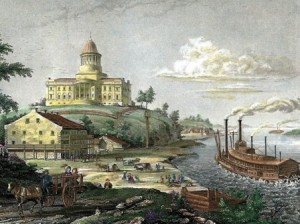 Between Then and Now, the town suffered a few tragedies; two capitol buildings burned and destroyed state records; in 1849 a cholera plague hit. Spirits were high in 1855 when the Pacific Railroad line was completed between St Louis and Jefferson City; as residents waited for the president of the railroad and other dignitaries to arrive on that first trip, a pier collapsed on a bridge across the Gasconade River and the resulting accident killed 28 people; it was the next year before regular train service began. The Civil War was a divisive time; Missouri’s governor favored the retention of slaves and secession; the state assembly voted to remain in the Union. The governor refused to recognize federal authority or to send troops to fight for the Union; instead he rallied volunteers for the state militia and marched from the capital to join Confederate forces at Booneville. But Union troops overran Jefferson City and pitched camp on Capitol Hill; the city remained in Union hands throughout the war.
Between Then and Now, the town suffered a few tragedies; two capitol buildings burned and destroyed state records; in 1849 a cholera plague hit. Spirits were high in 1855 when the Pacific Railroad line was completed between St Louis and Jefferson City; as residents waited for the president of the railroad and other dignitaries to arrive on that first trip, a pier collapsed on a bridge across the Gasconade River and the resulting accident killed 28 people; it was the next year before regular train service began. The Civil War was a divisive time; Missouri’s governor favored the retention of slaves and secession; the state assembly voted to remain in the Union. The governor refused to recognize federal authority or to send troops to fight for the Union; instead he rallied volunteers for the state militia and marched from the capital to join Confederate forces at Booneville. But Union troops overran Jefferson City and pitched camp on Capitol Hill; the city remained in Union hands throughout the war.
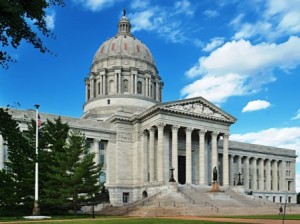 The rifts were healed eventually; industries such as printing and shoe manufacturing developed; people left their local farms and gravitated to the city. State government expanded and dominated the local scene however, throughout the periods of two world wars and the Great Depression, as it does today. Economic statistics in 2009 showed over 18,000 employed in state government; the next closest employer was education with just over a thousand. This is evidenced in the buildings you see; a walk along flag-lined High Street takes you past the magnificent state capitol, which occupies three blocks and is open for guided tours seven days a week; the State Museum is inside. Across the street is the Harry S Truman State Office Building (301 W High) which takes up a full block; inside is a Missouri Welcome Center and an 8-story atrium; also on that side of the street is the Supreme Court Building (207 W High); tours are available of this historic 1907 building which features glass floors in its library.
The rifts were healed eventually; industries such as printing and shoe manufacturing developed; people left their local farms and gravitated to the city. State government expanded and dominated the local scene however, throughout the periods of two world wars and the Great Depression, as it does today. Economic statistics in 2009 showed over 18,000 employed in state government; the next closest employer was education with just over a thousand. This is evidenced in the buildings you see; a walk along flag-lined High Street takes you past the magnificent state capitol, which occupies three blocks and is open for guided tours seven days a week; the State Museum is inside. Across the street is the Harry S Truman State Office Building (301 W High) which takes up a full block; inside is a Missouri Welcome Center and an 8-story atrium; also on that side of the street is the Supreme Court Building (207 W High); tours are available of this historic 1907 building which features glass floors in its library.
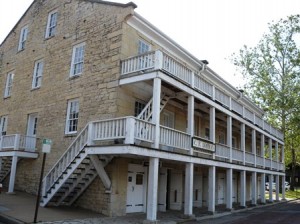 On the next blocks of High Street are the shops and stores sporting that comfortable 60’s-era look; at the bottom of the hill on Jefferson Street, just two blocks down and riverside, is the Lohman Building, Jefferson City’s oldest structure, dating back to 1830. It was the first store in town; a combination inn and warehouse too, serving steamboat passengers; it is open to visitors and offers a great film about the history of the area. The old Union Hotel is there as well, and open to visitors; the Amtrak station too; the entire area is deemed the Jefferson
On the next blocks of High Street are the shops and stores sporting that comfortable 60’s-era look; at the bottom of the hill on Jefferson Street, just two blocks down and riverside, is the Lohman Building, Jefferson City’s oldest structure, dating back to 1830. It was the first store in town; a combination inn and warehouse too, serving steamboat passengers; it is open to visitors and offers a great film about the history of the area. The old Union Hotel is there as well, and open to visitors; the Amtrak station too; the entire area is deemed the Jefferson 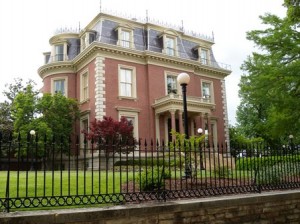 Landing State Historic Site. Back up the hill and over a block on Madison Street the Governor’s Mansion is still the governor’s home; a gorgeous sight to see with its mansard roof and Empire style; 34 first families have occupied it since 1871. It is maintained today by the nonprofit Missouri Mansion Preservation and is open for tours. Madison’s Café is the next block up, where owner Rob Agee will greet you by name, ask about the family, and make sure you get the table you want, inside or out on the sidewalk, near a pot of petunias.
Landing State Historic Site. Back up the hill and over a block on Madison Street the Governor’s Mansion is still the governor’s home; a gorgeous sight to see with its mansard roof and Empire style; 34 first families have occupied it since 1871. It is maintained today by the nonprofit Missouri Mansion Preservation and is open for tours. Madison’s Café is the next block up, where owner Rob Agee will greet you by name, ask about the family, and make sure you get the table you want, inside or out on the sidewalk, near a pot of petunias.
How’s that blood pressure now?
- Madison’s Café @ www.madisonscafe.com
- City of Jefferson @ www.jeffcitymo.org
- Jefferson City Visitors Bureau @ www.VisitJeffersonCity.com
- Missouri Department of Tourism @ www.visitmo.com

